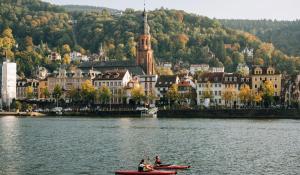
Back in the 1980s, photographer James Balog didn’t believe in global warming. Part of the reason was that he didn’t trust the veracity of the computer models that predicted the Earth’s temperature was rising. And part was that he simply couldn’t wrap his head around the idea.
“I didn’t think that humans were capable of changing the entire physics and chemistry of this entire huge planet. It didn’t seem probable. It didn’t seem possible,” he says in the new documentary, Chasing Ice.
But Balog is also a scientist, holding a master’s degree in geomorphology from the University of Colorado, and he soon realized that the scientific evidence was too overwhelming to ignore. Then he decided to “capture climate change in photographs.”
He traveled with a crew to the Solheim Glacier in Greenland, setting up cameras to track how the glacier changed within six months, from April to October. Normally, he says, glaciers demonstrate “a little bit of advance in the winter, and a little bit of retreat in the summer.” Solheim, however, was in full retreat, shrinking several hundred feet in length and deflating by two-thirds from its full height within the six months in which Balog observed it.
“That glacier had changed so much, that for three hours, we stood there looking at the prints from six months ago and looking at the glacier, going, ‘We must be wrong. We can’t be in the right place,’” Balog tells the camera.
That moment birthed a labor of love and concern called the Extreme Ice Survey (EIS), where Balog and his crew set up 25 cameras to take hourly photographs over three years, documenting changes in some of the world’s largest glaciers—12 in Greenland, five in Iceland, five in Alaska, and two in Montana.
Some of the most stunning footage captured by the EIS is on full display in Chasing Ice. Balog and his crew slog through mud and blizzards, crash through Arctic seas on ice-breakers, roll wagons of equipment across treacherous terrain, rappel down sheer ice cliffs, and even travel by dog sled to capture images that are arrestingly beautiful and profoundly shocking.
Perhaps the most poignant scene comes in the form of EIS footage from what is now known as the largest calving event (when a giant chunk of ice breaks off a glacier) ever caught on film. When the crew set up at Llulissat Glacier in Greenland—thought to be the glacier that birthed the iceberg that sank the Titanic—they witnessed a 75 minute spectacle as an enormous ice chunk the size of Lower Manhattan started to rumble and quake and tumble into the ocean, shooting ice chunks 600 feet into the air.
Watching Chasing Ice is as close as most of us will ever come to witnessing the miracle and the horror of a dying glacier. But it’s powerful enough. Footage from the film convinced Richard Ward, a former executive with Shell Oil, to quit his job and dedicate his life to get involved in combatting the climate crisis “in a much more profound way.” And it’s getting standing ovations from climate deniers in audiences across the country.
“The public doesn’t want to hear about more statistical studies, more computer models, more projections. What they need is a believable, understandable piece of visual evidence. Something that grabs them in the gut,” says Balog.
That’s exactly what Chasing Ice does.
—Tracy Fernandez Rysavy
![ChasingIce550w[1]](/sites/default/files/inline-images/ChasingIce550w%5B1%5D.jpg)
Chasing Ice filmmaker James Balog.







